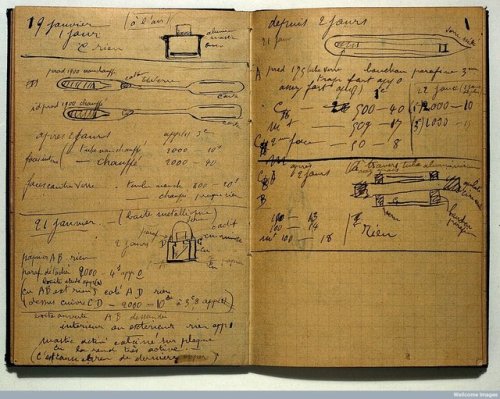POKÉMON FACT

POKÉMON FACT
More Posts from Mariaagnesi-fangirl-blog and Others
Perfection is not only the reason behind the passion but your hard work matters a lot for your passion.
S.S.K (via creativespacetime)
food is THE love language. let me bake you some fucking bread.

Marie Curie’s notebook from 1899-1902, containing notes from experiments on radioactive substances. The notebook is still radioactive and will be for 1,500 years. Photo: Wellcome Images.



A processional statue of the Blessed Mother in the sanctuary of St. Stanislaus Kostka in Pulaski Park, Chicago.


Home is where the Eucharist is ❤️
Interesting facts about stars
Stars are giant, luminous spheres of plasma. There are billions of them — including our own sun — in the Milky Way Galaxy. And there are billions of galaxies in the universe. So far, we have learned that hundreds also have planets orbiting them.
1. Stars are made of the same stuff

All stars begin from clouds of cold molecular hydrogen that gravitationally collapse. As they cloud collapses, it fragments into many pieces that will go on to form individual stars. The material collects into a ball that continues to collapse under its own gravity until it can ignite nuclear fusion at its core. This initial gas was formed during the Big Bang, and is always about 74% hydrogen and 25% helium. Over time, stars convert some of their hydrogen into helium. That’s why our Sun’s ratio is more like 70% hydrogen and 29% helium. But all stars start out with ¾ hydrogen and ¼ helium, with other trace elements.
2. Most stars are red dwarfs

If you could collect all the stars together and put them in piles, the biggest pile, by far, would be the red dwarfs. These are stars with less than 50% the mass of the Sun. Red dwarfs can even be as small as 7.5% the mass of the Sun. Below that point, the star doesn’t have the gravitational pressure to raise the temperature inside its core to begin nuclear fusion. Those are called brown dwarfs, or failed stars. Red dwarfs burn with less than 1/10,000th the energy of the Sun, and can sip away at their fuel for 10 trillion years before running out of hydrogen.
3. Mass = temperature = color

The color of stars can range from red to white to blue. Red is the coolest color; that’s a star with less than 3,500 Kelvin. Stars like our Sun are yellowish white and average around 6,000 Kelvin. The hottest stars are blue, which corresponds to surface temperatures above 12,000 Kelvin. So the temperature and color of a star are connected. Mass defines the temperature of a star. The more mass you have, the larger the star’s core is going to be, and the more nuclear fusion can be done at its core. This means that more energy reaches the surface of the star and increases its temperature. There’s a tricky exception to this: red giants. A typical red giant star can have the mass of our Sun, and would have been a white star all of its life. But as it nears the end of its life it increases in luminosity by a factor of 1000, and so it seems abnormally bright. But a blue giant star is just big, massive and hot.
4. Most stars come in multiples

It might look like all the stars are out there, all by themselves, but many come in pairs. These are binary stars, where two stars orbit a common center of gravity. And there are other systems out there with 3, 4 and even more stars. Just think of the beautiful sunrises you’d experience waking up on a world with 4 stars around it.
5. The biggest stars would engulf Saturn

Speaking of red giants, or in this case, red supergiants, there are some monster stars out there that really make our Sun look small. A familiar red supergiant is the star Betelgeuse in the constellation Orion. It has about 20 times the mass of the Sun, but it’s 1,000 times larger. But that’s nothing. The largest known star is the monster UY Scuti. It is a current and leading candidate for being the largest known star by radius and is also one of the most luminous of its kind. It has an estimated radius of 1,708 solar radii (1.188×109 kilometres; 7.94 astronomical units); thus a volume nearly 5 billion times that of the Sun.
6. There are many, many stars

Quick, how many stars are there in the Milky Way. You might be surprised to know that there are 200-400 billion stars in our galaxy. Each one is a separate island in space, perhaps with planets, and some may even have life.
7. The Sun is the closest star

Okay, this one you should know, but it’s pretty amazing to think that our own Sun, located a mere 150 million km away is average example of all the stars in the Universe. Our own Sun is classified as a G2 yellow dwarf star in the main sequence phase of its life. The Sun has been happily converting hydrogen into helium at its core for 4.5 billion years, and will likely continue doing so for another 7+ billion years. When the Sun runs out of fuel, it will become a red giant, bloating up many times its current size. As it expands, the Sun will consume Mercury, Venus and probably even Earth.
8. The biggest stars die early

Small stars like red dwarfs can live for trillions of years. But hypergiant stars, die early, because they burn their fuel quickly and become supernovae. On average, they live only a few tens of millions of years or less.
9. Failed stars

Brown dwarfs are substellar objects that occupy the mass range between the heaviest gas giant planets and the lightest stars, of approximately 13 to 75–80 Jupiter masses (MJ). Below this range are the sub-brown dwarfs, and above it are the lightest red dwarfs (M9 V). Unlike the stars in the main-sequence, brown dwarfs are not massive enough to sustain nuclear fusion of ordinary hydrogen (1H) to helium in their cores.
10. Sirius: The Brightest Star in the Night Sky

Sirius is a star system and the brightest star in the Earth’s night sky. With a visual apparent magnitude of −1.46, it is almost twice as bright as Canopus, the next brightest star. The system has the Bayer designation Alpha Canis Majoris (α CMa). What the naked eye perceives as a single star is a binary star system, consisting of a white main-sequence star of spectral type A0 or A1, termed Sirius A, and a faint white dwarf companion of spectral type DA2, called Sirius B.
To know more click the links: white dwarf, supernova, +stars, pulsars
sources: wikipedia and universetoday.com
image credits: NASA/JPL, Morgan Keenan, ESO, Philip Park / CC BY-SA 3.0



I saw some fine fellows on my morning walk today
-
 rumlicker liked this · 3 weeks ago
rumlicker liked this · 3 weeks ago -
 kasuminasai-blog liked this · 1 month ago
kasuminasai-blog liked this · 1 month ago -
 alexthebanditbastard reblogged this · 2 months ago
alexthebanditbastard reblogged this · 2 months ago -
 monophonicparallelogram reblogged this · 3 months ago
monophonicparallelogram reblogged this · 3 months ago -
 argonometra reblogged this · 3 months ago
argonometra reblogged this · 3 months ago -
 klonoadreams liked this · 5 months ago
klonoadreams liked this · 5 months ago -
 fuzzytheoristtyrant liked this · 5 months ago
fuzzytheoristtyrant liked this · 5 months ago -
 itssoooeasy liked this · 5 months ago
itssoooeasy liked this · 5 months ago -
 annayepsz liked this · 6 months ago
annayepsz liked this · 6 months ago -
 luxaii reblogged this · 6 months ago
luxaii reblogged this · 6 months ago -
 luxaii liked this · 6 months ago
luxaii liked this · 6 months ago -
 kassandra-wasp-hyena-girlthigh reblogged this · 7 months ago
kassandra-wasp-hyena-girlthigh reblogged this · 7 months ago -
 moxx-n-angel liked this · 7 months ago
moxx-n-angel liked this · 7 months ago -
 dinobilly425 reblogged this · 7 months ago
dinobilly425 reblogged this · 7 months ago -
 pixelatedboombursts reblogged this · 7 months ago
pixelatedboombursts reblogged this · 7 months ago -
 pixelatedboombursts liked this · 7 months ago
pixelatedboombursts liked this · 7 months ago -
 ifpainisbeauty-im-a-pretty-bitch liked this · 8 months ago
ifpainisbeauty-im-a-pretty-bitch liked this · 8 months ago -
 crownprinceknut liked this · 8 months ago
crownprinceknut liked this · 8 months ago -
 late-night-street-light reblogged this · 9 months ago
late-night-street-light reblogged this · 9 months ago -
 that-local-cryptid liked this · 9 months ago
that-local-cryptid liked this · 9 months ago -
 wertlossemendemon liked this · 9 months ago
wertlossemendemon liked this · 9 months ago -
 kiseki-no-robotto-translations liked this · 9 months ago
kiseki-no-robotto-translations liked this · 9 months ago -
 milliton reblogged this · 9 months ago
milliton reblogged this · 9 months ago -
 animelover8974 reblogged this · 9 months ago
animelover8974 reblogged this · 9 months ago -
 darklycola liked this · 9 months ago
darklycola liked this · 9 months ago -
 ryzzostar liked this · 10 months ago
ryzzostar liked this · 10 months ago -
 chamallex reblogged this · 1 year ago
chamallex reblogged this · 1 year ago -
 oxfordsonnets reblogged this · 1 year ago
oxfordsonnets reblogged this · 1 year ago -
 thesleepyhermit reblogged this · 1 year ago
thesleepyhermit reblogged this · 1 year ago -
 thesleepyhermit liked this · 1 year ago
thesleepyhermit liked this · 1 year ago -
 okunaitako liked this · 1 year ago
okunaitako liked this · 1 year ago -
 anime-lover324 liked this · 1 year ago
anime-lover324 liked this · 1 year ago -
 gotyouundermyskin reblogged this · 1 year ago
gotyouundermyskin reblogged this · 1 year ago -
 feelsaddict reblogged this · 1 year ago
feelsaddict reblogged this · 1 year ago -
 line-james reblogged this · 1 year ago
line-james reblogged this · 1 year ago -
 defense-attorney-steele reblogged this · 1 year ago
defense-attorney-steele reblogged this · 1 year ago -
 creamcloud0 reblogged this · 1 year ago
creamcloud0 reblogged this · 1 year ago -
 justabeanenjoyingstuff liked this · 1 year ago
justabeanenjoyingstuff liked this · 1 year ago -
 snow-playing-cello reblogged this · 1 year ago
snow-playing-cello reblogged this · 1 year ago -
 justgetsloud reblogged this · 1 year ago
justgetsloud reblogged this · 1 year ago -
 aetrix liked this · 1 year ago
aetrix liked this · 1 year ago -
 jean-luc-pikachu reblogged this · 1 year ago
jean-luc-pikachu reblogged this · 1 year ago -
 sapphiclovrboy liked this · 1 year ago
sapphiclovrboy liked this · 1 year ago -
 anxietywithfriesblog liked this · 1 year ago
anxietywithfriesblog liked this · 1 year ago -
 butch-saralance reblogged this · 1 year ago
butch-saralance reblogged this · 1 year ago -
 jellyfemmedyke liked this · 1 year ago
jellyfemmedyke liked this · 1 year ago -
 the44th reblogged this · 1 year ago
the44th reblogged this · 1 year ago

"There is a pre-established harmony between thought and reality. Nature is the art of God." - Gottfried Willhelm Leibniz
164 posts